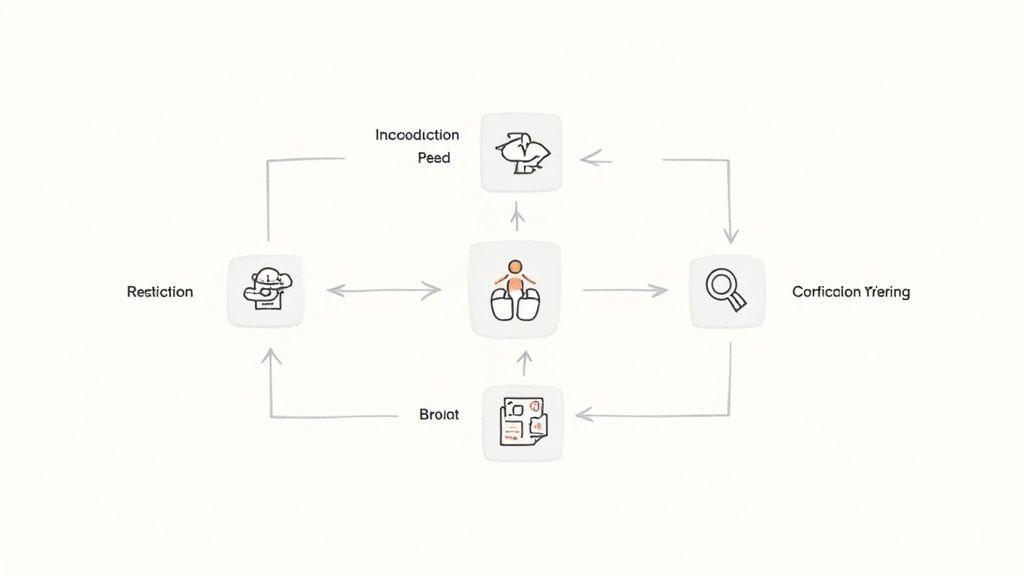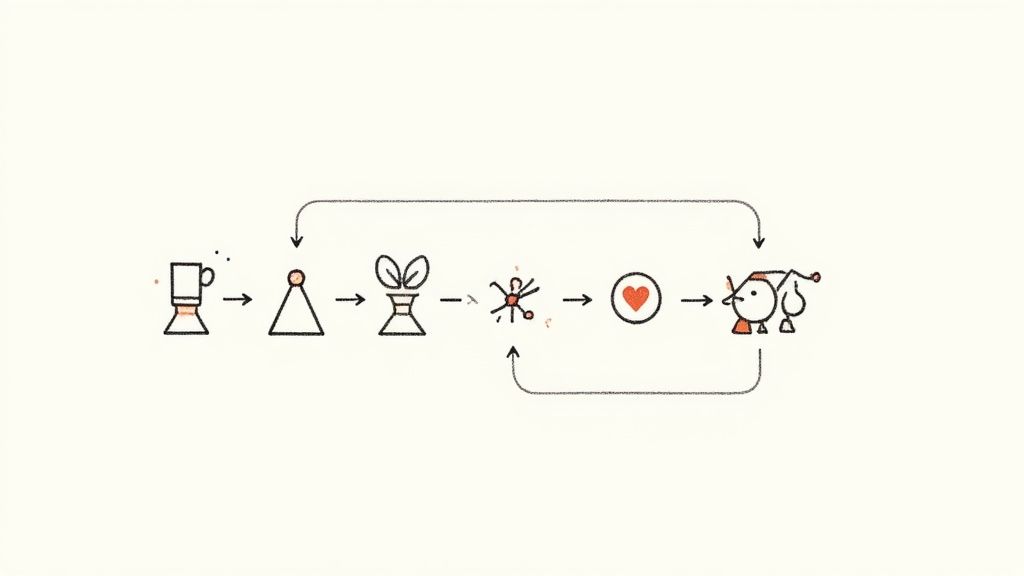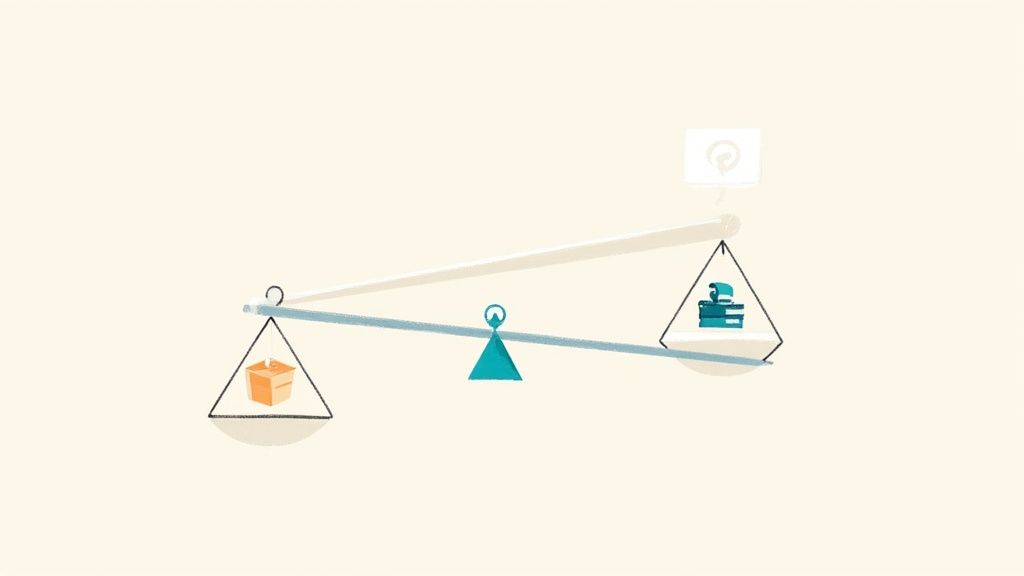Transform Training with the 10 20 70 Model


The 10 20 70 Model: Evolution of Workplace Learning

The modern workplace requires constant adaptation and learning. This has shifted how organizations approach professional development, moving beyond traditional, formal training. The 10 20 70 model offers a dynamic framework for cultivating continuous growth. It proposes that learning is multifaceted, achieved through a balanced approach.
The 10 20 70 model suggests that roughly 70% of learning happens through on-the-job experiences, 20% through social interaction, and 10% via formal training. Developed over 40 years ago, this model has significantly impacted learning and development (L&D) strategies. It highlights the often-overlooked importance of experiential learning and social interactions. More detailed statistics can be found here: 70 20 10 Institute. This model reflects how professionals naturally develop and refine their skills.
Experiential Learning (70%)
Experiential learning is the cornerstone of the 10 20 70 model. This involves learning by doing, applying knowledge, and reflecting on the results. Individuals gain practical experience, build confidence, and develop problem-solving skills.
For example, a new software developer learns more by working on a live project than through passive learning. Hands-on experience allows them to encounter challenges, discover solutions, and solidify their understanding of coding.
Social Learning (20%)
Social learning, the next vital component, involves interactions with colleagues, mentors, and peers. Discussions, feedback, and observation provide new perspectives and learning opportunities.
This collaborative environment fosters a sense of community and shared learning. Mentorship programs, peer-to-peer coaching, and informal conversations all contribute to a continuous feedback loop, reinforcing skills and promoting development.
Formal Learning (10%)
While experiential and social learning are key, formal learning still plays a vital role. This includes structured programs, online courses, and workshops. Formal training provides a foundational understanding of core concepts.
This foundational knowledge acts as a springboard for experiential and social learning. For instance, a formal project management training session equips individuals with essential tools and techniques before practical application. This framework supports building practical skills.
The 10 20 70 model isn't a rigid formula, but a flexible guideline. The proportions may vary depending on the industry, role, or individual. However, the core principle remains: learning is most effective when blending experience, interaction, and structured learning. This model empowers individuals to take ownership of their development and creates a more engaging learning experience.
Mastering The 70: Experiential Learning That Sticks
The 70% dedicated to experiential learning within the 10 20 70 model forms the foundation of effective development. In high-performing organizations, this isn't a passive activity. Instead, it's a carefully nurtured environment where employees learn by actively doing, applying knowledge, and reflecting on the results. This hands-on method mirrors how professionals naturally cultivate expertise and encourages deeper, more enduring learning.
Designing Purposeful On-The-Job Experiences
Actively creating opportunities for team members to expand their skill sets and acquire practical experience is key. Stretch assignments, for example, challenge individuals with responsibilities slightly outside their current comfort zone. This offers a safe environment to acquire new skills while contributing to significant projects.
Cross-functional projects allow employees to broaden their perspectives by collaborating with colleagues from different departments. This exposure to diverse viewpoints nurtures valuable collaboration skills and facilitates a cross-pollination of knowledge, strengthening the entire organization.
Job rotations provide a structured approach for team members to experience different roles within the company. This not only expands their skill set and network but also helps them discover career paths aligned with their interests, empowering them to contribute more effectively to overall organizational success.
Balancing Challenge And Support
Simply placing employees in challenging situations without the right support isn't effective. Managers must strike a balance between providing appropriate challenges and offering adequate support. This creates a learning environment where team members feel empowered to take risks, learn from mistakes, and grow without the fear of failure.
Providing clear expectations, regular feedback, and access to mentorship are vital. These elements ensure that challenging experiences promote growth rather than burnout. They also reinforce the concept of learning as a continuous process, not a one-time event. The 10 20 70 model has been influential in moving learning and development (L&D) away from traditional formal training and toward more experiential and social methods. This shift is especially important in today's rapidly evolving business world where new skill requirements constantly emerge. In the UK, businesses increasingly realize the need to go beyond traditional L&D to maintain a competitive edge. For more detailed information, visit People Management.
Measuring Experiential Learning Outcomes
Measuring the effectiveness of experiential learning requires more than just subjective feedback. It demands a focus on tangible results. This might include monitoring project success rates, improvements in Key Performance Indicators (KPIs), or even the creation of new, innovative solutions. By linking experiential learning to measurable results, organizations can demonstrate the genuine impact of the 10 20 70 model on their bottom line. This data-driven approach underscores the model's value and offers insights for continuous improvement.
Unlocking the 20: Social Learning That Transforms

While experiential learning comprises the majority of development in the 10 20 70 model, social learning plays a significant role. This 20%, centered on interaction and collaboration, amplifies the effects of on-the-job experiences. This section explores how organizations can best structure social learning to maximize both knowledge transfer and skill development.
Structured Social Learning: Beyond Casual Conversations
Effective social learning initiatives extend beyond informal conversations. They involve dedicated, structured environments where knowledge sharing and feedback are actively encouraged and facilitated. This often requires a shift from informal interactions to purposeful activities that promote real capability building.
Cultivating Meaningful Interactions
What are some specific ways to structure these interactions? Let's examine a few effective social learning methods.
Mentoring Programs: Pairing experienced employees with newer team members provides invaluable guidance and support. Structured mentoring conversations, with clear objectives and regular check-ins, help ensure that these relationships deliver tangible results.
Communities of Practice: These groups, focused on specific areas of expertise, create dedicated platforms for sharing best practices, problem-solving, and collective learning. Communities of Practice can be particularly helpful in breaking down organizational silos and accelerating innovation.
Peer Coaching: This collaborative approach allows colleagues to learn from each other through structured feedback and mutual support. This reciprocal learning fosters a culture of continuous improvement and shared accountability.
Fostering Psychological Safety and Constructive Feedback
Creating a psychologically safe environment is essential for successful social learning. This empowers individuals to take risks, ask questions, and admit mistakes without fear of judgment. This sense of safety encourages open communication and deeper engagement in the learning process.
Facilitating constructive feedback exchanges is also crucial. This involves training individuals on how to give and receive feedback effectively, focusing on specific behaviors and their impact rather than personal criticism. This approach maximizes the learning potential of social interactions.
Adapting Social Learning for Remote and Hybrid Environments
Many organizations now operate in remote or hybrid settings. This necessitates adapting social learning approaches to bridge geographical distances and maintain connections. Utilizing technology effectively is key to ensuring meaningful connections and knowledge sharing regardless of location.
Online platforms, virtual communities, and video conferencing tools like Zoom can facilitate these connections. Thoughtful design and facilitation of online social learning experiences are essential to maintaining engagement and effectiveness within the 10 20 70 model.
Comparing Social Learning Methods
To help illustrate the various approaches, the following table summarizes several social learning methods, outlining their benefits, challenges, and best use cases. This comparison provides a framework for organizations seeking to optimize the social learning component of their development strategy.
Effective Social Learning Methods Comparison: This table compares different social learning approaches, outlining their benefits, challenges, and implementation considerations.
| Method | Primary Benefits | Implementation Challenges | Best For | Digital Enablement |
|---|---|---|---|---|
| Mentoring Programs | Knowledge transfer, career guidance, improved employee engagement | Finding suitable mentors, matching mentor-mentee pairs effectively | Individual development, career progression | Online platforms, video conferencing |
| Communities of Practice | Shared learning, problem-solving, innovation, breaking down silos | Maintaining engagement, facilitating knowledge sharing effectively | Groups with shared interests or expertise, fostering collaboration | Online forums, virtual meeting spaces |
| Peer Coaching | Skill development, mutual support, accountability, improved communication | Ensuring psychological safety, training effective coaching skills | Developing specific skills, fostering teamwork, improving performance | Video conferencing, online feedback tools |
Key takeaways from this comparison include the importance of tailoring the chosen method to the specific learning objective and the need for careful planning and execution to overcome implementation challenges.
By strategically implementing these methods and fostering supportive learning environments, organizations can unlock the full potential of the 10 20 70 model and drive substantial improvements in both employee development and organizational performance.
Optimizing the 10: When Formal Learning Really Matters
Formal learning, the 10% portion of the 70 20 10 model, might appear small, but it forms the crucial foundation for experiential and social learning. Think of it as the bedrock of a house: essential for stability and supporting everything built upon it. This section explores how to maximize the impact of formal learning for a strong return on investment (ROI).
Designing High-Impact Formal Learning
Formal training shouldn't be isolated. It needs strategic design to complement on-the-job experiences. This starts with targeted programs addressing specific skill gaps and connecting directly to real-world challenges employees face. Engaging content delivered through diverse methods keeps learners motivated and promotes deeper understanding. This could include interactive workshops, online modules, simulations, or even gamified learning experiences.
Blending Learning Modalities and Spaced Repetition
Optimizing formal learning involves blending different learning modalities. Combining online courses with in-person workshops, for example, caters to varied learning styles and reinforces key concepts. Spaced repetition, a technique that reviews material at increasing intervals, further strengthens knowledge retention and combats forgetting.
Ensuring Knowledge Transfer Through Instructional Design
Effective instructional design is paramount. This means creating learning experiences that prioritize knowledge transfer and practical application. Activities should go beyond passive information absorption and encourage active engagement. Case studies, group projects, and simulations allow learners to apply new knowledge in realistic scenarios, bridging the gap between theory and practice.
Measuring Formal Learning Effectiveness
Going beyond simple completion rates is crucial for understanding the effectiveness of formal learning. Assessing knowledge acquisition, skill development, and behavioral changes through pre- and post-training assessments gives a more complete picture. This data-driven approach helps pinpoint areas for improvement and ensures training investments align with organizational goals. However, the 70 20 10 model has drawn criticism for potential oversimplification. For further perspectives, explore more about the 70 20 10 model: CIPHR.
Supporting Broader Development Objectives
Formal learning should actively support the wider goals of experiential and social learning. This could mean preparing learners for challenging assignments, providing foundational knowledge for mentoring, or equipping them with skills for participating in communities of practice. By strategically aligning formal training with other learning modes, organizations can create an integrated development ecosystem. This holistic approach makes learning an integral part of the organizational culture, driving continuous growth and better performance.
Measuring What Matters: ROI of the 10 20 70 Model

Measuring the effectiveness of the 10 20 70 model requires a shift in perspective. Instead of focusing solely on traditional learning metrics like course completion rates, we need to consider the broader impact on business performance. This section explores practical frameworks for evaluating the true ROI of this learning approach.
Metrics for Each Learning Mode
Effective measurement of the 10 20 70 model relies on choosing the right metrics for each learning mode. For experiential learning (70%), the emphasis should be on tangible outcomes.
This could include tracking project success rates, improvements in Key Performance Indicators (KPIs), or the development of new and innovative solutions. These real-world results offer concrete evidence of learning's impact.
For social learning (20%), metrics should reflect knowledge sharing and collaboration. Network analysis tools like Pajek can reveal the strength of learning connections within teams.
Furthermore, tracking the frequency of mentoring sessions and participation in communities of practice provides insights into the effectiveness of social learning activities.
Finally, while formal learning (10%) remains important, its measurement should go beyond mere completion rates. Pre- and post-training assessments are crucial for gauging knowledge acquisition and skill development. This offers a more complete picture of formal learning’s effectiveness.
Building a Balanced Scorecard
A balanced scorecard is an invaluable tool for connecting learning investments to business results. It involves aligning learning metrics with overarching organizational goals.
For instance, if a key business objective is improving customer satisfaction, learning metrics could track improvements in customer service skills and their correlation with customer feedback scores.
This integrated approach highlights the 10 20 70 model's contribution to strategic objectives. It also provides a framework for ongoing evaluation and continuous improvement of learning strategies.
Avoiding Measurement Pitfalls
While measuring ROI is crucial, avoiding common pitfalls is equally important. Focusing only on easily quantifiable metrics can create a skewed understanding of the true impact.
It’s vital to balance quantitative data with qualitative feedback. Employee surveys and interviews provide valuable context and insights into the effectiveness of learning programs.
Another common mistake is neglecting the long-term impact of learning. Skill development takes time to translate into measurable business results. ROI measurement should consider both short-term gains and long-term improvements in organizational capabilities.
Learning From Case Studies
Real-world examples provide invaluable learning opportunities. Case studies of organizations that have effectively measured the ROI of their 10 20 70 learning strategies offer practical lessons.
Understanding their challenges, successes, and chosen metrics can inform the development of your own measurement framework.
Framework for the 10 20 70 Model Measurement:
The following table offers a practical framework for measuring the effectiveness of the 10 20 70 model. It outlines key metrics, data collection methods, success indicators, and common challenges for each component of the model.
| Learning Component | Key Metrics | Data Collection Methods | Success Indicators | Common Challenges |
|---|---|---|---|---|
| Experiential (70%) | Project success rates, KPI improvements | Performance reviews, project reports | Increased productivity, improved quality | Isolating learning impact from other factors |
| Social (20%) | Network analysis, mentoring frequency | Surveys, observation, platform analytics | Increased collaboration, knowledge sharing | Measuring qualitative aspects like knowledge transfer |
| Formal (10%) | Pre/post-training assessments, engagement | Tests, quizzes, feedback forms, platform analytics | Improved knowledge, skill application | Linking formal learning to on-the-job performance |
By implementing these principles, organizations can gain a deeper understanding of the 10 20 70 model's impact. This data-driven approach ensures learning investments align with business objectives and contribute to meaningful organizational growth.
Retention Power: The 10 20 70 Model's Hidden Advantage
The 10 20 70 model isn't simply about acquiring new skills; it's a powerful tool for boosting employee engagement and retention. By providing a well-rounded approach to learning, organizations can cultivate a sense of value and purpose that keeps top talent engaged and invested.
Creating Psychological Ownership Through Development
When employees actively participate in shaping their learning journey, a sense of psychological ownership develops. This means they feel more invested in their own growth and, as a result, more connected to the organization. The 10 20 70 model, emphasizing experiential and social learning, naturally encourages this ownership. Employees aren't passively receiving training; they actively contribute to their development through practical experiences and collaborative interactions. This active involvement creates a stronger sense of belonging and commitment.
Increasing Internal Mobility and Growth Opportunities
The 10 20 70 model can significantly enhance internal mobility. By encouraging employees to learn through experience and social interaction, organizations develop a more adaptable and dynamic talent pool. The varied skills gained through hands-on learning and knowledge sharing through social interactions equip employees for a broader range of roles within the company. This increased flexibility creates more internal opportunities for advancement, fostering a sense of career progression and reducing the likelihood of employees seeking growth elsewhere.
Reducing Turnover Through Investment in Learning
Studies show that employees who feel valued by their employers tend to stay longer. In fact, according to LinkedIn, 94% of employees would stay with a company longer if it invested in their learning and development. The 10 20 70 model provides a framework for organizations to effectively structure these investments. By emphasizing on-the-job learning and social interactions, organizations can create a more engaging and supportive learning environment. This approach is especially relevant in the UK, where talent retention is a major concern. Learn more about the role of the 70 20 10 model in talent retention: Let's Talk Talent. By implementing the 10 20 70 model, organizations can improve employee engagement, performance, and retention, ultimately contributing to their long-term success.
Communicating the Value of Your Learning Philosophy
Presenting your organization's learning approach as a competitive advantage is critical for attracting and retaining top talent. Clearly communicating the benefits of the 10 20 70 model to both current and prospective employees is key.
This involves highlighting how the model empowers employees to take control of their development, encourages continuous growth, and fosters a supportive learning environment. Sharing success stories of employees who have thrived under the 10 20 70 model can further showcase its positive impact.
Building a Culture of Continuous Learning
Successfully implementing the 10 20 70 model requires more than just introducing new programs. It requires fostering a culture where continuous learning is a shared value, not just an HR initiative.
This means providing opportunities for employees to design their own learning paths, ensuring growth opportunities are visible and accessible, and integrating learning into daily work routines. When learning becomes an integral part of the organizational culture, it cultivates a sense of shared purpose and ongoing growth, ultimately boosting both individual and organizational performance.
Future of the 10 20 70 Model: What's Next?

The 10 20 70 model, while a well-established learning framework, is not a static concept. Its implementation continues to evolve alongside changing workplace dynamics and advancements in technology. This means organizations must remain adaptable and forward-thinking to truly harness its power.
The Impact of Emerging Technologies
Technology is rapidly changing the way we learn, creating new possibilities for the 10 20 70 model. AI-powered tools, for instance, can personalize learning experiences within the 10% dedicated to formal learning, offering customized resources and individual support.
Virtual Reality (VR) offers exciting potential for the 70% experiential learning component, creating immersive simulations for risk-free practice in realistic scenarios. This is especially valuable for roles that require hands-on skill development. Virtual Reality is proving useful for a range of training applications.
Furthermore, advanced analytics offer a more in-depth understanding of learning effectiveness across all three segments of the model. This data-driven insight allows for continuous optimization of training programs.
Adapting to Remote and Hybrid Work Environments
The growing prevalence of remote and hybrid work presents both challenges and opportunities. The 10 20 70 model, with its focus on social and experiential learning, requires careful consideration in these new work environments.
Progressive organizations are using technology to connect remote teams, fostering meaningful interactions and collaboration through virtual platforms and online communities of practice. This directly addresses the 20% allocated to social learning, ensuring that interaction and knowledge sharing thrive, even when teams are physically separated.
Remote mentoring programs and virtual project collaborations are also becoming essential for facilitating experiential learning in distributed work settings.
Personalizing Learning Journeys with Data
Data is playing an increasingly critical role in personalizing learning experiences. Organizations are using data-driven strategies to tailor learning paths based on individual employee needs, strengths, and career goals.
This doesn't invalidate the core structure of the 10 20 70 model. Instead, it refines the delivery of each element. Formal training becomes more focused, experiential learning opportunities are more aligned with individual skill gaps, and social connections are nurtured based on shared learning objectives.
Expert Predictions and Recommendations
Experts predict a continued emphasis on experiential and social learning in the future. While formal learning will remain important, it will likely become even more closely integrated with the other two components. The primary focus will shift from pure information delivery to creating environments that encourage curiosity, experimentation, and collaboration.
To prepare your learning strategy for the future, prioritize a culture of continuous learning. Empower employees to take charge of their own development, offer access to diverse learning opportunities, and use technology to connect, collaborate, and learn effectively. This adaptability will ensure that learning remains relevant and impactful in a constantly evolving work environment.
Building a Successful Future with the 10 20 70 Model
The 10 20 70 model provides a dynamic framework for professional development. It promotes a well-rounded approach that incorporates formal training, social interaction, and experiential learning to drive employee growth and, ultimately, organizational success.
The model’s adaptability makes it a powerful tool for navigating the changing world of workplace learning. By embracing innovation, integrating technology, and utilizing a data-driven approach, organizations can truly unlock the full potential of the 10 20 70 model.
Are you ready to empower your team's growth and development through coaching and mentorship? Visit Coaching Hub (https://coaching-hub.net) for valuable resources and support in implementing the 10 20 70 model within your coaching practice or organization.